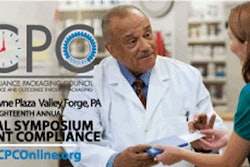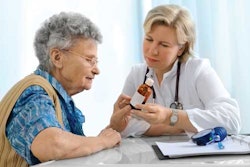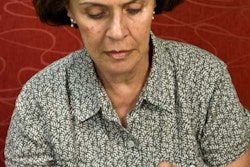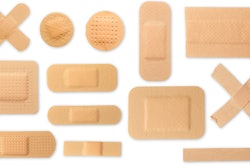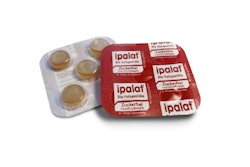
Broader use of compliance-prompting packaging (CPP) in the U.S. has been elusive, often stalled by cost concerns. Yet healthcare reform may potentially prove to the “tipping point” in negating cost as the key driver. How? As healthcare reform begins to take shape, “physicians, pharmacists, and hospitals will make money by making people healthier and improving patient health outcomes,“ said Walter Berghahn, vice president of packaging technology for Amerisource Bergen Packaging Group.
Berghahn, who also serves as chairman of the board of directors of the Healthcare Compliance Packaging Council (HCPC), made the remarks at the opening of HCPC's 18th Annual National Symposium on Patient Compliance May 5 in Valley Forge, PA.
John O'Brien, executive director of the Responsible Health Institute, noted that innovative pilot programs pack the potential to increase the use of CPP if the hospital or medical home can show that such packaging produces improved health outcomes.
O'Brien, who delivered the presentation, “U.S. Regulatory Healthcare Update,” at the Symposium, said, “There's a need to realize that pill boxes and amber vials may no longer work well in compliance. It will be exciting when pharmacies see compliance-prompting packaging as addressing medical problems and improving health outcomes and overall costs.”
O'Brien said the new “model of healthcare will be different than primary care, with a focus on prevention.” He cited medical homes and patient engagement as promising developments in the healthcare community. Medical and technological advancements could create exciting new products in the future, he noted. For example, he mentioned a glucose meter that could synch with a portable electronic device that could reward a young adult for lowering their A1C number in countering diabetes.
Edwina Rogers, executive director of The Patient Centered Primary Care Collaborative, spoke on “The National Patient Centered Medical Home Movement.” She explained how patient-centered medical home program integrate patients as active participants in their own health and wellbeing, with their primary caregiver serving as the point person in the medical home program. A goal of the medical home movement is to improve patient health in a cost-effective manner. Rogers pointed out that presently there is not a focus on compliance-prompting packaging, but encouraged HCPC attendees to become active and form a task force group to address the role of packaging in the medical home movement.
Based on judging that took place at Interphex New York, in which Healthcare Packaging Publisher Jim Chrzan served as one of the judges, HCPC honored four packages, with its 2009 Compliance Package of the Year awarded to Pfizer for its Toviaz carded blister pack, done in partnership with Anderson Packaging. Pfizer executives are shown in the accompanying photo, including Debra M. Copeletti, manager/team leader, Packaging Design and Development, Packaging Services, for Pfizer Global Manufacturing, New York, NY. More coverage of the package will be provided in the June issues of Healthcare Packaging and Packaging World magazines.
Some other highlights from the HCPC Symposium included the following:
• Doctors are being driven by seeing more patients and financial issues, not spending more time with patients, said Tassilo Korab, executive director of HCPC Europe. He said, “There's a need to design patient-friendly packaging.” He pointed out, “about half of all patients with chronic diseases stop refilling prescriptions by one year.” In one of his presentation slides, Korab quoted a consultant as saying, “Pharma spends as little as possible to help the patient (that is the consumer). Other industries recognize the significance of helping the consumer (that is the patient) and make the packaging improve function, interest, accessibility and add value…”
• Cypak's vice president of sales Danevert Asbrink, spoke about electronic compliance packaging in improving patient care and clinical outcomes. He cited an example of Meridian Health, a not-for-profit healthcare organization in New Jersey with four hospitals, in-home and community-based services and nursing homes employing electronics to create products and tools related to medication management, pain management, and other chronic conditions.
• Laura Bix, associate professor at Michigan State University's School of Packaging, made the presentation, “Package Usability and Human Interface Model.” She said, “Packaging has become a more important touch point than ever before in history. Healthcare communities online, such as Twitter and Facebook, are opening discussion about products, and packaging takes on a role in attracting and retaining customers. There's a need to meet and exceed [customer] needs.”
Bix pointed to an important differentation in which there's a need to “shift from product-centered design and protective packaging at minimal cost with little user input to bring the same level of quantitative science to interface between people and packaging.”
Berghahn, who also serves as chairman of the board of directors of the Healthcare Compliance Packaging Council (HCPC), made the remarks at the opening of HCPC's 18th Annual National Symposium on Patient Compliance May 5 in Valley Forge, PA.
John O'Brien, executive director of the Responsible Health Institute, noted that innovative pilot programs pack the potential to increase the use of CPP if the hospital or medical home can show that such packaging produces improved health outcomes.
O'Brien, who delivered the presentation, “U.S. Regulatory Healthcare Update,” at the Symposium, said, “There's a need to realize that pill boxes and amber vials may no longer work well in compliance. It will be exciting when pharmacies see compliance-prompting packaging as addressing medical problems and improving health outcomes and overall costs.”
O'Brien said the new “model of healthcare will be different than primary care, with a focus on prevention.” He cited medical homes and patient engagement as promising developments in the healthcare community. Medical and technological advancements could create exciting new products in the future, he noted. For example, he mentioned a glucose meter that could synch with a portable electronic device that could reward a young adult for lowering their A1C number in countering diabetes.
Edwina Rogers, executive director of The Patient Centered Primary Care Collaborative, spoke on “The National Patient Centered Medical Home Movement.” She explained how patient-centered medical home program integrate patients as active participants in their own health and wellbeing, with their primary caregiver serving as the point person in the medical home program. A goal of the medical home movement is to improve patient health in a cost-effective manner. Rogers pointed out that presently there is not a focus on compliance-prompting packaging, but encouraged HCPC attendees to become active and form a task force group to address the role of packaging in the medical home movement.
Based on judging that took place at Interphex New York, in which Healthcare Packaging Publisher Jim Chrzan served as one of the judges, HCPC honored four packages, with its 2009 Compliance Package of the Year awarded to Pfizer for its Toviaz carded blister pack, done in partnership with Anderson Packaging. Pfizer executives are shown in the accompanying photo, including Debra M. Copeletti, manager/team leader, Packaging Design and Development, Packaging Services, for Pfizer Global Manufacturing, New York, NY. More coverage of the package will be provided in the June issues of Healthcare Packaging and Packaging World magazines.
Some other highlights from the HCPC Symposium included the following:
• Doctors are being driven by seeing more patients and financial issues, not spending more time with patients, said Tassilo Korab, executive director of HCPC Europe. He said, “There's a need to design patient-friendly packaging.” He pointed out, “about half of all patients with chronic diseases stop refilling prescriptions by one year.” In one of his presentation slides, Korab quoted a consultant as saying, “Pharma spends as little as possible to help the patient (that is the consumer). Other industries recognize the significance of helping the consumer (that is the patient) and make the packaging improve function, interest, accessibility and add value…”
• Cypak's vice president of sales Danevert Asbrink, spoke about electronic compliance packaging in improving patient care and clinical outcomes. He cited an example of Meridian Health, a not-for-profit healthcare organization in New Jersey with four hospitals, in-home and community-based services and nursing homes employing electronics to create products and tools related to medication management, pain management, and other chronic conditions.
• Laura Bix, associate professor at Michigan State University's School of Packaging, made the presentation, “Package Usability and Human Interface Model.” She said, “Packaging has become a more important touch point than ever before in history. Healthcare communities online, such as Twitter and Facebook, are opening discussion about products, and packaging takes on a role in attracting and retaining customers. There's a need to meet and exceed [customer] needs.”
Bix pointed to an important differentation in which there's a need to “shift from product-centered design and protective packaging at minimal cost with little user input to bring the same level of quantitative science to interface between people and packaging.”

